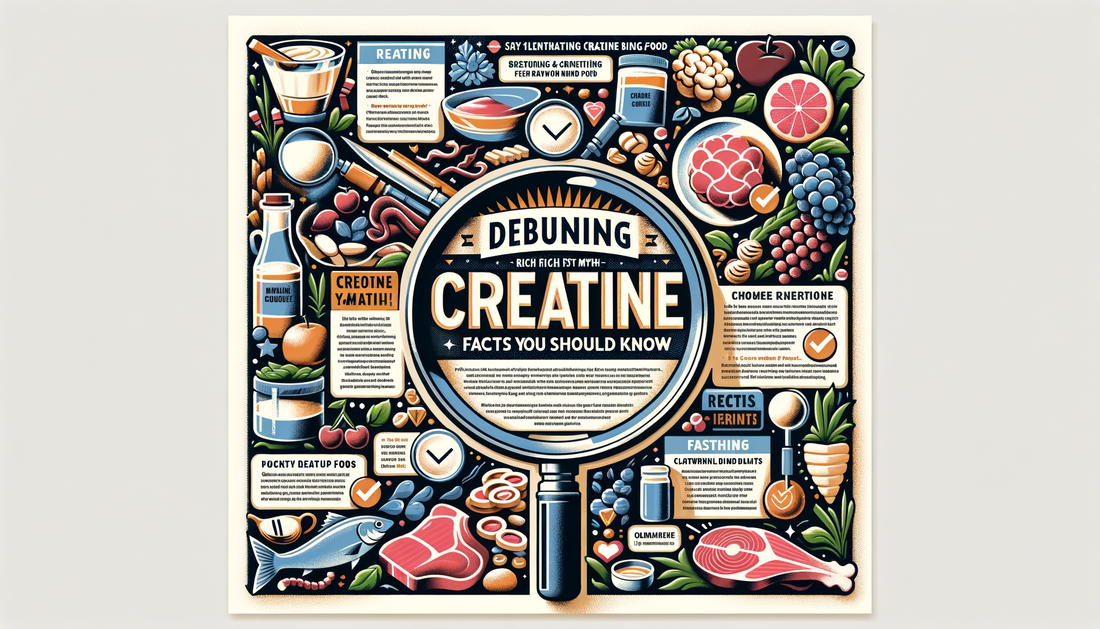Debunking Creatine-Rich Foods Myths – Facts You Should Know
Creatine is one of the most researched and effective supplements for boosting muscle performance, strength, and recovery. However, many people believe that they can get enough creatine from their diet alone. Are creatine-rich foods truly enough, or is supplementation necessary? Let’s separate the myths from the facts and uncover the real story behind dietary creatine sources.
Table of Contents
- What Is Creatine?
- How Much Creatine Is in Foods?
- Myths About Creatine-Rich Foods
- Should You Take Creatine Supplements?
- The Best Way to Increase Your Creatine Intake
- Conclusion
What Is Creatine?
Creatine is a naturally occurring compound found in muscle cells. It plays a crucial role in the production of adenosine triphosphate (ATP), which provides energy for high-intensity activities like sprinting, weightlifting, and explosive movements. The human body produces creatine in the liver, kidneys, and pancreas, but it can also be obtained from dietary sources.
Extensive research has been conducted on creatine’s benefits, safety, and efficacy, making it one of the most studied supplements in the sports and medical fields. According to a comprehensive review by the Journal of the International Society of Sports Nutrition, creatine supplementation is widely regarded as both effective and safe for improving muscle performance.
How Much Creatine Is in Foods?
Although creatine is present in certain animal-based foods, the amount available is relatively small compared to the recommended intake for athletic performance. Here are some common sources of creatine-rich foods:
- Beef (steak): Approximately 2g of creatine per pound.
- Salmon: Roughly 1.4–2g of creatine per pound.
- Chicken: Around 1.5g of creatine per pound.
- Pork: Similar to beef, providing about 2g per pound.
- Tuna: Contains around 1.8g of creatine per pound.
Despite these sources, the challenge is that to meet the standard creatine supplementation recommendation of 3-5g per day, you would need to consume large amounts of these foods daily. For example, eating over 2 pounds of steak just to get 5g of creatine isn’t very practical.
Myths About Creatine-Rich Foods
Myth #1: You Can Get Enough Creatine From Food Alone
While it’s true that creatine exists in foods like meat and fish, the amount absorbed through diet alone is often insufficient for athletes or those looking to maximize performance. Most fitness experts recommend supplementation for optimal muscle saturation.
Myth #2: Vegetarians and Vegans Can Get Creatine From Plants
Unlike protein, where plant-based sources exist, there are no significant plant-based sources of creatine. This means that individuals who follow a vegetarian or vegan diet may have lower creatine levels and can significantly benefit from supplementation.
Research supports the fact that creatine supplementation can be particularly beneficial for vegetarians and vegans. A study addressing misconceptions about creatine found that those who do not consume animal products may have lower baseline creatine levels but experience notable improvements in cognitive function and physical performance when supplementing.
Myth #3: Cooking Meat Doesn’t Affect Creatine Levels
Cooking meat—especially at high temperatures—can degrade creatine content. If you rely on meat for your creatine intake, remember that raw meat contains more creatine than cooked meat, reducing the effectiveness of dietary intake.
Myth #4: The Body Doesn’t Need Extra Creatine
Although the human body produces creatine naturally, it only synthesizes about 1-2g per day. This may be enough for basic metabolic functions but not for peak athletic performance, making supplementation a smart choice.
Should You Take Creatine Supplements?
To truly optimize your performance and recovery, consuming creatine supplements is one of the most effective and convenient strategies. Instead of trying to eat massive amounts of meat daily, Wild Gainz Creatine Gummies provide a simple, digestible, and tasty alternative to meet your daily creatine needs.
Benefits of Creatine Supplementation:
- Improved Muscle Growth: Helps increase muscle mass and strength.
- Faster Recovery: Reduces muscle fatigue and speeds up recovery time after workouts.
- Enhanced Performance: Boosts high-intensity exercise performance.
- Brain Function Support: Aids cognitive function and mental clarity (research suggests creatine benefits brain function in addition to muscle health).
The Best Way to Increase Your Creatine Intake
If you’re serious about improving your fitness and recovery, simply relying on creatine-rich foods may not be enough. Instead, consider a high-quality creatine supplement for consistent and measurable benefits. While creatine powders are an option, they often come with poor mixability and chalky textures. That’s where a better alternative comes in—creatine gummies.
Wild Gainz Creatine Gummies deliver an effective and tasty way to meet your daily creatine goals without the hassle of mixing powders or consuming too much meat. With an easy-to-consume gummy format, they make supplementation seamless and enjoyable.
Conclusion
While some foods naturally contain creatine, the amount needed for muscle performance and recovery makes full dietary reliance impractical. Many common beliefs about creatine-rich foods don’t hold up under scrutiny, and those seeking optimal athletic performance should consider supplementation.
By incorporating an easy, convenient, and tasty solution like Wild Gainz Creatine Gummies, you can ensure you’re getting the right amount of creatine daily—without the hassle of excessive meat consumption.
Are you ready to take your performance to the next level? Try creatine gummies today and experience the difference!


